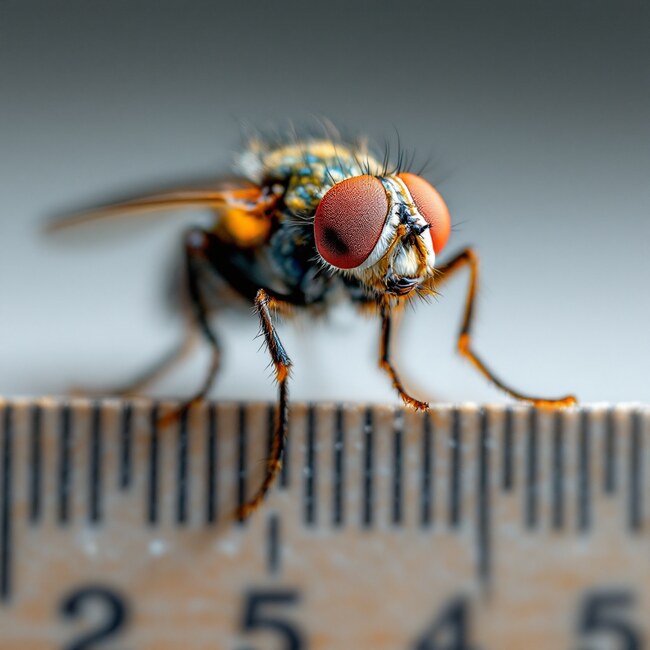House flies are among the most common insects in the world. Most people encounter them daily, often swatting at their buzzing presence. But this raises an interesting question: how big do house flies get? Are they as large as they seem, or does their erratic flight and persistent nature make them appear bigger than they are?
Understanding House Flies
What Is a House Fly?
The house fly, scientifically known as Musca domestica, is one of the most widespread insect species on the planet. These flies are found on every continent except Antarctica, thriving in environments where humans live. Their adaptability stems from their preference for warm temperatures, abundant food sources, and decaying organic matter, making urban and suburban habitats ideal.
House flies are part of the larger Muscidae family, which includes other fly species, but Musca domestica is by far the most well-known. Their ability to breed quickly and survive in various climates has made them a global pest.
Why Do People Think House Flies Are Big?
Many people perceive house flies as larger than they are. Why? The answer lies in our interactions with them.
- Close Proximity: House flies often buzz near our faces or land on food, making them appear larger than they truly are.
- Erratic Flight Patterns: Their quick, unpredictable movements can make them seem intimidating, exaggerating their size in our minds.
- Media and Myths: Movies, cartoons, and other media often depict house flies as larger-than-life pests, leading to misconceptions about their size.
While house flies are relatively small compared to many other insects, their constant presence indoors makes them feel much bigger than they are.
How Big Do House Flies Get?
Precise Measurements
House flies are small, but their size can vary slightly. Here are the typical dimensions of an adult house fly:
You may also read (cleaning)
- Length: 4–8 mm (0.16–0.31 inches)
- Body Width: 1.3–2.5 mm
- Wingspan: 13–15 mm (0.51–0.59 inches)
Most house flies you encounter will fall within this range, with the average size leaning closer to 6–7 mm in length. Their bodies are grayish, with four distinct black stripes on their thorax. Their large, red compound eyes are another prominent feature, making them easy to identify.
Male vs. Female Size
Interestingly, male and female houseflies have a noticeable size difference. Females are typically larger than males.
- The larger size of females is primarily due to their reproductive role. They need more body mass to support egg production and laying.
- Conversely, males are slightly smaller and more active, often seen competing for mates.
Size Throughout the Life Cycle
House flies undergo a complete metamorphosis, transitioning through four distinct life stages: egg, larva, pupa, and adult. Their size changes significantly during each stage:
- Egg: Housefly eggs are about 1.2 mm long and white. They are laid in clusters, often in decaying organic material.
- Larva (Maggot): The larval stage is the longest, with maggots growing to 7–12 mm long, often appearing larger than the eventual adult fly.
- Pupa: Pupae are about 8 mm long, encased in a reddish-brown shell as they transition into adults.
- Adult: The adult house fly emerges at 4–8 mm, typically smaller than the larval stage.
House Fly Size in Context
Comparison With Other Common Flies
How does the house fly stack up against other fly species? Here’s a comparison:
Fly SpeciesAdult LengthWingspanNotable Features
House Fly 4–8 mm 13–15 mm Gray, 4 stripes, red eyes
Fruit Fly 2–4 mm 3–6 mm Tan/yellow, red eyes
Blow Fly 6–14 mm 13–20 mm Metallic green/blue
Horse Fly 10–25 mm 20–30 mm Large, biting mouthparts
Compared to larger flies like horse flies or blow flies, house flies are relatively small. However, they are significantly larger than fruit flies, another common household pest.
Are House Flies Really “Big”?
In reality, house flies are not particularly large insects. However, their behavior and proximity to humans often make them seem bigger than they are.
- Indoor Presence: Inside homes, where insects are less common, house flies can feel intrusive and larger than life.
- Optical Illusions: Their quick movements and buzzing can exaggerate their size in our perception.
- Behavioral Traits: House flies’ tendency to hover around faces or food makes them more noticeable, adding to the illusion of size.
Factors Affecting House Fly Size
Genetics and Species Variation
Not all houseflies are created equal. While Musca domestica is the most common species, other members of the Muscidae family can vary slightly in size. Genetic factors also play a role in determining the size of individual flies.
Environmental Influences
Environmental conditions significantly affect house fly size. These include:
- Nutrition: Larvae that develop in nutrient-rich environments tend to grow larger.
- Temperature: Warmer climates speed development but often result in smaller adult flies.
- Humidity: High humidity levels are optimal for larval growth, leading to larger flies.
Urban vs. Rural Flies
Flies in urban areas may differ in size from their rural counterparts. Urban flies often have access to more consistent food sources but may face greater competition, leading to variations in size.
Why Does House Fly Size Matter?
Health and Hygiene Implications
The size of a house fly doesn’t directly impact its ability to spread disease. However, larger flies may be more noticeable and harder to ignore. House flies are known carriers of harmful bacteria regardless of size, making their presence a health concern.
Pest Control Considerations
Understanding the size of house flies can help with pest control. Larger flies may indicate a different species, requiring specific strategies to eliminate them. Monitoring fly size can also provide insights into environmental conditions contributing to an infestation.
Myths and Misconceptions About House Fly Size
Many myths surround house flies, including claims that they can grow as large as coins. These misconceptions often arise from confusion with other fly species or exaggerated media portrayals. House flies are small, and any “giant” flies you see are likely a different species altogether.
How to Identify a House Fly by Size and Appearance
When identifying house flies, look for these key characteristics:
- Size: 4–8 mm in length, with a wingspan of 13–15 mm.
- Color: Gray body with four black stripes on the thorax.
- Eyes: Large, red compound eyes.
- Wings: Transparent with distinct veins.
Practical Tips for Homeowners
- Monitor Fly Size: You may deal with a different species if you notice unusually large flies.
- Keep Areas Clean: Reducing food waste and cleaning surfaces can minimize fly activity.
- Use Fly Traps: Sticky or UV light traps can help control house fly populations.
You may also read (why do midges appear in your house)

